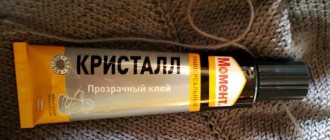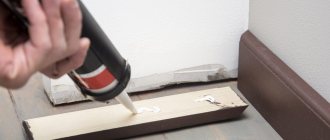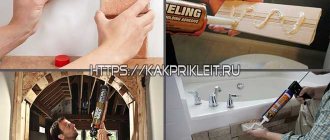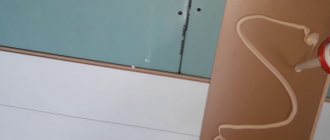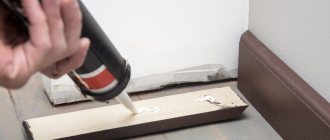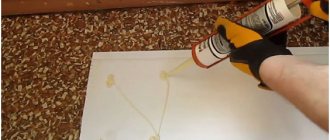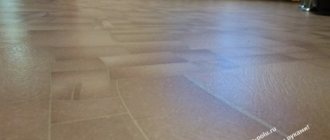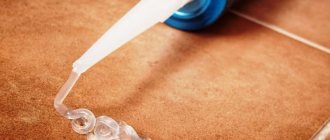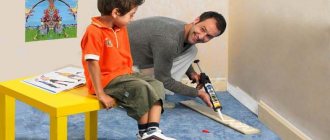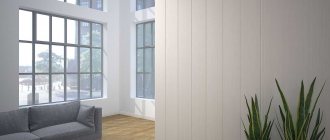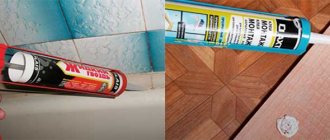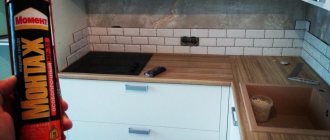This type of glue, such as liquid nails, is now very actively used in construction and repair. When performing installation, there are simply no analogues for it. In some situations, liquid nails can speed up and significantly simplify the work process. Liquid nails “Moment Installation” allow you to avoid using a hammer drill, hammers, self-tapping screws, screws and other parts in your work. It is worth considering in more detail the existing varieties of liquid nails and the main areas of their application.
Purpose
Construction adhesive “Moment Installation” is used for the following purposes:
- for installing mirror bases on different planes;
- for attaching PVC panels;
- to attach shelves and decorative structures to any base;
- for fastening tiles.
The glue is waterproof, which allows it to be used in conditions of excessive dampness. They can be used to glue tiles or mirrors in bathrooms, showers, swimming pools, kitchens, etc.
Basic principles of installing slabs using liquid nails
- Before gluing to a fresh concrete base, you must wait a month for the moisture to completely evaporate, as well as other substances that are released during the hardening process.
- The painted base must first be sanded to remove the gloss. Then just install the PVC panels.
- “Moment” assembly adhesive should be applied with constant pressure, in a strip in the shape of a snake or straight lines along the perimeter of the slab with a distance of approximately 2 cm from the edge.
- Rubber glue sets within a quarter of an hour. Therefore, when using it, a rapid evaporation operation should be carried out, then the tile is installed in place and pressed tightly mechanically (using a screed, brackets). After a day, the clamps can be removed.
Moment liquid nails adhesive is a simple and convenient replacement and addition to the traditional mechanical method of fastening products and parts during construction and finishing work indoors and outdoors. Due to the absence of metal fasteners, the finished structure looks neat and harmonious. Moment Montage adhesive is one of the most popular and affordable of all similar materials.
Types and composition
Based on synthetic polymers
Additional components are solvents of organic origin, which explains the pungent aroma. Liquid nails react with plastic and PVC, so it is not recommended to connect surfaces made of these materials.
The marking on the products of this group is “MR”, it is placed on the packaging. Synthetic compounds are highly durable and resistant to moisture. Due to easy flammability, use of the product near open flame is prohibited.
Acrylic based
The marking indicated on the container is “MB”. They are neutral in composition, so they are suitable for work inside the house. Usually they install baseboards, fillets or PVC tiles.
Manufacturers of products display all information about the composition, main qualities and types of materials that can be glued together on the packaging and official website.
Features of choosing liquid nails Moment for different materials
To make life easier for the buyer and quickly guide him in choosing the right assembly adhesive, the manufacturer has divided its products into categories, indicating the characteristics of the composition and the type of materials it is aimed at:
- Installation of ceramics and metal objects. All MP brands are used - “Universal”, “Extra Strong”, “For Panels”, “Instant Grip”. For indoor work, acrylic mounting nails Express MV-50 are used.
- Installation of mirrors. Special adhesive Moment Installation MP-50 does not contain compounds that can destroy amalgam. With its help, mirrors are attached to any type of surface - wood, concrete, paint, metal. After hardening, it remains elastic and does not shift the mirror vertically under its own weight.
- Work in conditions of high humidity. To carry out installation work in bathrooms, bathrooms, and swimming pools, use moisture-resistant Moment Installation brand MB-40. Adhesive based on polyurethane prepolymers MF-80, cyanide-free, with sealant properties.
Using liquid nails in the bathroom
- Interior finishing works. Express Decor (MB-45) is ideal for gluing polystyrene panels, skirting boards and ceiling decorative friezes. Thanks to its white color, the glued decorative element forms a single whole with the structure. The gluing seams are invisible, since after drying the glue gives minimal shrinkage.
- Installation of heavy panels and large structures. For these purposes, mixtures with increased primary setting values are used. Among acrylic liquid nails, this is Super Strong Plus with a primary grip force of up to 100 kg/m2. From rubber – “Extra-strength”, “For Panels” (MP-55, MP-35, respectively).
Stamps
Glue Moment “Liquid Nails” is produced in 16 variations. Each has its own adhesive strength, differs in composition and is designed for a specific material.
Express MV 50
Universal assembly adhesive, does not contain solvents, used for joining wood, PVC, insulating boards. You can plant baguettes, door jambs, and decorative elements.
“One for everything. Super strong"
Manufactured using Flexec technology. Plastic, monocomponent, has a high adhesive force, so it can be used to glue heavy and large elements. They can work on any surface with any porosity, seal cracks, and seal.
Moisture accelerates the hardening of the joint, so it can be used in rooms with high dampness. They can be used to connect natural stone, concrete, brick. The product is not used for working with glass, copper, brass and PVC.
“One for everything. Transparent"
It has the advantages of the previous brand, it helps to seal seams in water, but not in conditions of constant immersion. Shelf life: no more than 15 months.
Glue Express Decor
White acrylic composition. Quickly glues any materials, but maximum adhesive ability is achieved with hygroscopic surfaces. Suitable for fixing decor.
“Moment Montage. Waterproof"
It belongs to moisture-resistant products of class D. This is a universal composition marked MB-40. They can firmly glue any materials.
"Super strong MVP 70. Transparent"
Due to the gripping force of 70 kg/m. sq. quickly glues any materials. Typically, wall panels and interior design elements are mounted on it. There is also a white composition.
"Superstrong Lux MV-100"
It has the qualities of the previous brand, but its adhesion force is 100 kg/m. sq. To glue heavy elements to them, there is no need to use supports or clamps.
"Extra-strong MP-55"
It is made on the basis of rubber. They can be used to glue heavy objects of any texture. After application, it forms a thin film that is dry to the touch, protecting the bonded surface from contamination.
The strongest adhesion occurs at the first contact of the surfaces during the destruction of the protective shell, so it is not recommended to move the working elements after bonding.
Liquid nails on synthetic resins
This type of adhesive mixtures is intended for installation work. They contain evaporating substances that are harmful to health, so work is carried out in well-ventilated areas.
All rubber compounds are characterized by the following:
- increased moisture resistance of the connection allows the use of glue in places of constant contact with water;
- more often used as a sealant;
- attach structural elements and materials to any base: brick, concrete, wood, metal, glass, PVC or chipboard;
- perfectly glues polished, non-porous surfaces;
- the resulting connection is elastic and resistant to vibration;
Important! Certain types of liquid nails based on synthetic resins are suitable for gluing polystyrene foam, but this is done in rare cases.
The technology for carrying out the work differs from the use of acrylic glue. Surfaces treated with liquid nails are first joined, then immediately diluted to allow the solvent to evaporate, which helps improve the initial bond. After 7-10 minutes, the elements are reconnected and pressed tightly. Excess glue cannot be removed with water; you will have to use a solvent; in addition, there is a high probability of damaging adjacent elements.
Specifications
Rubber based
| Compound: | Contains toxic volatile substances that give the glue a pungent odor, so when working with it you need to carefully ventilate the room. |
| Special Features: | Moisture resistance, frost resistance (operating temperature can reach -40 °C) |
| Color: | Flesh color, there are white and colorless models. |
| Application: | Installation, but can be used as a sealant. |
| Type of glued material: | Almost anyone. |
| Type of bonded surfaces: | Better glues smooth surfaces that do not absorb moisture. |
| Drying time: | Some varieties can dry instantly. The average working time, depending on the brand, can be 10-30 minutes. It sets within a day, and liquid nails dry completely in a maximum of 7 days. |
| Operating temperature: | -12… +35 °C |
| storage t°C: | From -20 to +30 °C, fully restored after defrosting. |
| Solvent: | White Spirit. |
| Expiration date: | 1.5-2 g. |
| Consumption per 1m2: | Depends on the brand. |
| Release form: | Cartridges, tubes. Weight 0.125-0.4 kg. |
Water based
| Compound: | Does not contain toxic substances, no pungent odor. Has great gripping force. |
| Special Features: | Water resistance, frost resistance (up to -20 °C) |
| Color: | White, colorless after drying. |
| Application: | For installation indoors and outdoors. |
| Type of glued material: | Various materials. |
| Type of bonded surfaces: | The surface must absorb moisture. |
| Drying time: | The working time of the train is 5-15 minutes. When completely dry, you can paint with acrylic paints. |
| Operating temperature: | +5… +30 °C |
| storage t°C: | From +5 to +30 °C |
| Solvent: | Excess glue can be easily removed with a damp sponge. |
| Expiration date: | 18 months |
| Consumption per 1m2: | Depends on the brand. |
| Release form: | Cartridges, tubes. Weight 0.125-0.4 kg. |
Instructions for use
During work, you must follow safety rules.
Before starting gluing work, you need to clean the surfaces from dirt and foreign objects, sand them, then degrease them. The materials to be bonded must be at room temperature.
The optimal air temperature for work is +10 °C and above. Some types of polymer adhesives can be used at subzero temperatures.
If the glue is in the form of a cartridge, then before use you need to cut off the protective seal and put on the cap. The end of the cap is cut at an angle of 45° to the desired diameter.
Next, the cartridge is installed in the construction gun: press the locking tab, pull the rod towards you, insert the cartridge into the gun body, push the rod back until the disk stops at the bottom of the cylinder.
Make several idle trigger presses until the glue starts to come out. To stop feeding, press the locking tab. This movement reduces the pressure of the compound inside the cartridge.
Adviсe
- It is better to use a construction gun to apply the product. It can later be used to work with sealant.
- If work is carried out on newly constructed concrete walls , then it is better to postpone this for at least a month to allow the surface to dry and the concrete to set.
- If you plan to glue PVC panels to painted walls , they must first be sanded. If the surface does not absorb moisture well, then it is better not to use acrylic nails or to prime the surface first.
- To increase the adhesive properties of expanded polystyrene , it is first coated with wood glue, which is diluted with water 1 to 1. After drying, you can begin to apply the glue.
Complete curing of the composition requires from 12 to 24 hours; during this time it is not recommended to load the glued surfaces, so as not to reduce the quality of the gluing.
Is it possible to make liquid nails with your own hands?
On the Internet you can find descriptions of many ways to make glue with your own hands, using only available objects and products. Will such a composition perform its functions? It is unlikely that it will compare in characteristics with “liquid nails Moment Installation”, manufactured industrially.
When creating “liquid nails”, components are used that cannot be purchased, and it is impossible to reproduce the manufacturing technology at home. You can try to glue small objects together with homemade glue, for example, a broken toy, but you should not use them for household repairs and construction.
It is closest to “liquid nails” in terms of the method of applying hot-melt adhesive in the form of solid rods, which are inserted into a hot-melt gun and melt under high temperature. If “liquid nails” are not available, then hot melt glue can replace them in some cases.
Liquid nails - a new generation construction adhesive
Liquid nails are a special type of construction adhesive that allows you to reliably connect dissimilar structural elements. The ability to withstand loads of up to 80 kg/cm2 is a distinctive feature of liquid nails, which makes them indispensable for a number of repair and installation works. In addition, they have several other important advantages:
- heat and moisture resistant;
- do not deform the surfaces with which they come into contact;
- allow you to fasten parts that do not fit tightly together;
- resistant to corrosion and mechanical stress;
- environmentally friendly.
